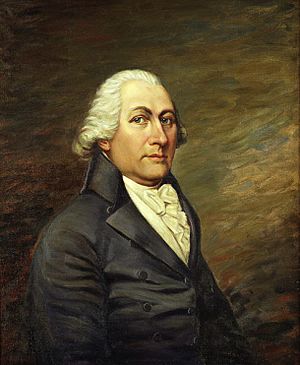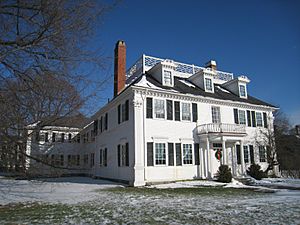John Langdon (politician) facts for kids
Quick facts for kids
John Langdon
|
|
|---|---|
 |
|
| 2nd President of New Hampshire and 3rd Governor of New Hampshire | |
| In office June 5, 1810 as Governor – June 5, 1812 |
|
| Preceded by | Jeremiah Smith |
| Succeeded by | William Plumer |
| In office June 6, 1805 as Governor – June 8, 1809 |
|
| Preceded by | John Taylor Gilman |
| Succeeded by | Jeremiah Smith |
| In office June 4, 1788 as President – January 22, 1789 |
|
| Preceded by | John Sullivan |
| Succeeded by | John Sullivan |
| In office June 1, 1785 as President – June 7, 1786 |
|
| Preceded by | Meshech Weare |
| Succeeded by | John Sullivan |
| President pro tempore of the United States Senate | |
| In office November 5, 1792 – December 2, 1793 |
|
| Preceded by | Richard Henry Lee |
| Succeeded by | Ralph Izard |
| In office April 6, 1789 – August 9, 1789 |
|
| Preceded by | Position established |
| Succeeded by | Richard Henry Lee |
| United States Senator from New Hampshire |
|
| In office March 4, 1789 – March 3, 1801 |
|
| Preceded by | Seat established |
| Succeeded by | James Sheafe |
| Personal details | |
| Born | June 26, 1741 Portsmouth, New Hampshire, British America |
| Died | September 18, 1819 (aged 78) Portsmouth, New Hampshire, U.S. |
| Political party | Pro-Administration Anti-Administration Democratic-Republican |
| Signature | |
John Langdon (born June 26, 1741 – died September 18, 1819) was an important politician from Portsmouth, New Hampshire. He is known as one of the Founding Fathers of the United States.
Langdon played a big role in creating the United States. He attended the meeting where the U.S. Constitution was written. He also signed this important document. Later, he became one of the first two U.S. senators for New Hampshire.
Before all this, Langdon was a strong supporter of the Revolutionary War. He was part of the Continental Congress, which was like the first government of the American colonies. He served in the United States Congress for 12 years. He was even the first person to hold the job of president pro tempore of the Senate. This role means he led the Senate when the Vice President was not there. After his time in Congress, he became the president and then governor of New Hampshire. In 1812, he was asked to be a candidate for U.S. vice president, but he said no.
Contents
Early Life and Business
John Langdon's family came to America before 1660. His father was a successful farmer and built ships. The Langdon family was among the first to settle near the Piscataqua River. This area grew into Portsmouth, which became a major seaport in New England.
John went to a local school. After school, he and his older brother, Woodbury Langdon, decided not to become farmers. Instead, they learned about shipping and trade.
By the time he was 22, John Langdon was a ship captain. He sailed cargo ships to the Caribbean. Four years later, he owned his first merchant ship. Over time, he built a small fleet of ships. These ships were part of the "triangle trade." They sailed between Portsmouth, the Caribbean, and London. By 1777, both John and his brother were among the richest people in Portsmouth.
Role in the American Revolution
The British government controlled shipping very strictly. This made it hard for Langdon's business to grow. Because of this, he became a strong supporter of the American Revolution in the 1770s.
He joined committees in New Hampshire that worked against British rule. In 1774, he helped take British weapons from Fort William and Mary. This was an early act of rebellion.
Langdon was a member of the Second Continental Congress from 1775 to 1776. He worked on the Marine Committee, which helped create the American navy. He later signed the U.S. Constitution. In June 1776, he left Congress. He became an agent for the American forces fighting the British. He oversaw the building of several warships. These included the "Raleigh", the "America", and the "Ranger."
In 1777, he helped fund a military mission against the British. He took part in the Battle of Bennington. He also led a group of volunteer soldiers called Langdon's Company of Light Horse Volunteers. They fought in the Battle of Saratoga and the Battle of Rhode Island.
Political Career and Public Service

In 1784, John Langdon built a large house in Portsmouth. This house is now known as the Governor John Langdon House.
Langdon was elected as the president of New Hampshire two times. He served from 1785 to 1786 and again from 1788 to 1789. He was also a member of the Congress of the Confederation in 1787. This was the government before the Constitution.
In 1787, he became president of the Constitutional Convention. This was the meeting where the U.S. Constitution was written. He was part of the New Hampshire group at this important meeting.
Langdon was elected to the United States Senate. He served as a senator from March 4, 1789, to March 3, 1801. On April 6, 1789, he was chosen as the first president pro tempore of the Senate. He also held this role during the Second Congress.
During the 1787 debates about the Constitution, Langdon shared his ideas. He was a strong supporter of the Constitution. On June 21, 1788, New Hampshire voted to approve the Constitution. This was a very important moment. New Hampshire was the ninth state to approve it, which meant the Constitution could officially start. Langdon quickly wrote to George Washington to tell him the good news. He called New Hampshire the "Key Stone in the Great Arch."
In 1798, Langdon helped a woman named Oney Judge. She had escaped slavery from George and Martha Washington. Langdon helped her avoid being captured and returned to slavery.
Langdon continued his public service. He was a member of the New Hampshire Legislature from 1801 to 1805. For two of those years, he was the speaker, meaning he led the meetings. He then served as governor of New Hampshire from 1805 to 1812. There was a short break in his term between 1809 and 1810. In 1812, he was offered the chance to be the vice presidential candidate with James Madison, but he chose not to accept.
Death and Lasting Impact
John Langdon passed away in Portsmouth in 1819. He was buried in the Langdon Tomb in the North Cemetery.
To honor his memory, the town of Langdon, New Hampshire, was named after him. There is also a Langdon Street in Madison, Wisconsin. Many streets in Madison are named after important Founding Fathers.
Images for kids
See also
 In Spanish: John Langdon para niños
In Spanish: John Langdon para niños



